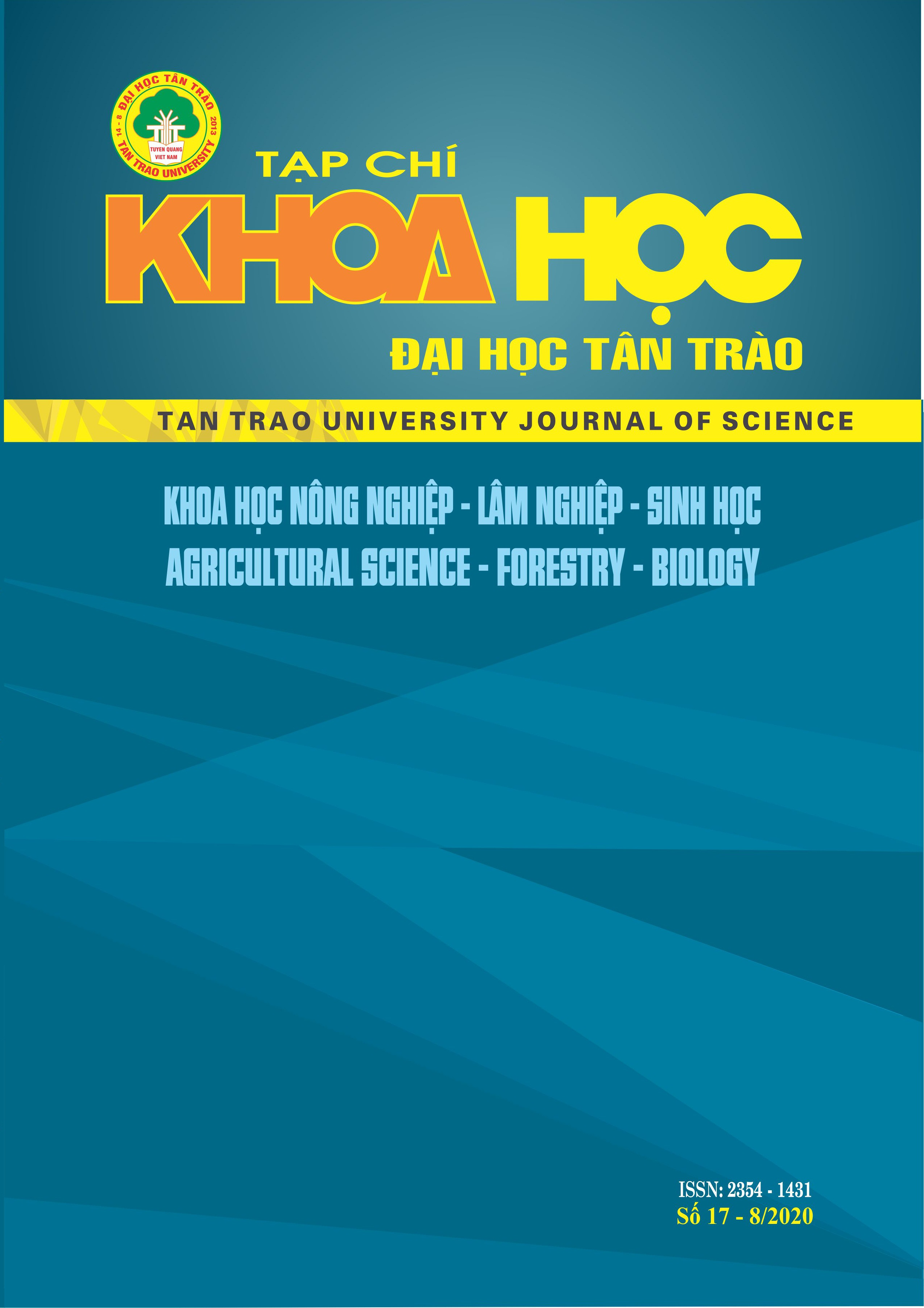NGHIÊN CỨU THÀNH PHẦN HÓA HỌC VÀ VI SINH VẬT CỦA RƯỢU VANG SIM THU HÁI TẠI XÃ CÔN LÔN HUYỆN NA HANG, TỈNH TUYÊN QUANG
DOI:
https://doi.org/10.51453/2354-1431/2020/382Từ khóa:
Rhodomyrtus tomentosa, Saccharomyces cerevisiae, rượu vangTóm tắt
Rượu vang là loại đồ uống có cồn nhẹ được lên men trực tiếp từ dịch quả mà không trải qua quá trình chưng cất. Rượu vang sim rừng Na Hang được sản xuất từ dịch ép quả sim (Rhodomyrtus tomentosa) sử dụng chủng nấm men Saccharomyces cerevisiae S5 đã được nghiên cứu tuyển chọn, định danh theo quy trình sản xuất vang sim rừng Na Hang [1]. Với mong muốn xây dựng bộ tiêu chí công bố chất lượng cho rượu vang sim, thành phần hóa học, vi sinh vật của vang sim được xác định bằng các phương pháp phân tích hiện đại. Thành phần rượu vang sim thu được có chỉ tiêu hóa học (ethanol 12.5 g/l, acid bay hơi 3mg/l, hàm lượng rượu bậc cao 328.32 mg/l, hàm lượng ester 281.92 mg/l, hàm lượng aldehyde 34.1 mg/l, không có methanol), vi sinh vật (vi sinh vật hiếu khí là 166 ± 7 CFU/ml, tổng số nấm men và nấm mốc 4 ± 0,2 CFU/ml, không phát hiện E. coli, Cl. perfringens, Strep. feacal) và giá trị cảm quan tốt. Thành phần vang sim rừng Na Hang đạt tiêu chuẩn rượu vang Việt Nam.
Tải xuống
Tài liệu tham khảo
1. Hoang Thi Le Thuong. Research on selection of yeast strains for wine production from Sim fruit (Rhodomyrtus tomentosa) in Con Lon commune, Na Hang district. Final report of the project grassroots level 2019, p.2
2. Bird D., Understanding wine technology: the science of wine explained. Board and Bench Publishing, 2011, p.28.
3. Legras J.L, et al., Bread, beer and wine: Saccharomyces cerevisiae diversity reflects human history, Molecular ecology 16(10) 2007 p. 2091.
4. Vietnam Alcohol and Beverage Association. Conference: Vietnam Alcohol and Beverage Association, Vietnam wine market: There is still great potential, 2014.
5. Vu Cong Hau.Technological process of producing fruit wine in the family: oranges; grapefruit; toad (Yunnan crocodile); wild strawberry; mulberry; pineapple; dig; Passionflower; mangosteen; plum; dream; grapes; mango; apple; fabric. Final report of the state-level project, 2017, p.14.
6. Dang Hong Anh, Nguyen Thi Hoai Tram, Le Thanh Mai. Selection of yeast strains for wine fermentation in Vietnam. Scientific conference. Hanoi, 2006 p.6.
7. Boulton, R.B., et al., Principles and practices of winemaking. Springer Science & Business Media 6(3) 1999 p.251.
8. Jin, G.m., C.p. Lin, and R. Zhong, Research on the stability of the flavonoid glycosides during the fermentation process of the rhodomyrtus tomemtosa wine [J]. Food Science and Technology, 2006, p5.
9. Fenglin, H. and Z.S.L. Ruili, Preparation of wine from the Berries of Downy Rosemyrtle. Economic Forest Reseaches, 1997, p2.
10. Nguyen Van Binh. Report on acceptance of the grassroots-level project: Research on wine production (Rhodomyrtus tomentosa) .University of Agriculture and Forestry, Thai Nguyen, 2012.
11. National standards, Determination of tannin according to Vietnam Standard - Tanin 2020, Hanoi.
12. National standard 11672: 2016 - Determination of vitamin C (reduced ascorbic acid) - Titration method, 2016.
13. National standards, Determination of total acid according to TCVN 8012: 2009, 2016.]
14. National standards, Distilled alcohol - Determination of alcohol concentration, Hanoi, 2009.]
15. National standard, Distilled alcohol: Determination of total aldehydes, Hanoi, 2009.
16. National standard TCVN 8011: 2009 on Distilled wine - Method of determination of high alcohol content and ethyl acetate by gas chromatography, Hanoi, 2016.
17. National standard TCVN 7929: 2008 (EN 14083: 2003) about Food - Determination of trace elements - Determination of lead, cadmium, chromium, molybdenum by atomic absorption spectrometer using graphite furnace (GFAAS) after pressure decomposition, Hanoi, 2017
18. Vietnamese standard, Microorganisms in food and animal feeds - Enumeration method Staphylococci positively reacts with coagulase on agar plates - Part 1: Technique using Baird - parker agar environment, Hanoi, 2005.
19. Ngo Minh Thuy. Stabilizing and enhancing the quality of sim wine by chemical and biological methods. Journal of Science, Can Tho University, 2010: p.165.
20. Foodstuffs Commission Regulation (EC) No 1881/2006 of 19 December 2006 setting maximum levels for certain contaminants in foodstuffs.
21. Ministry of Health, National technical regulations for alcoholic beverages QCVN 6-3: 2010 / BYT, 2010.
22. Paine, A.J. and A.D. Dayan, Defining a tolerable concentration of methanol in alcoholic drinks. Human & Experimental Toxicology, 20(11)
Tải xuống
Đã Xuất bản
Cách trích dẫn
Số
Chuyên mục
Giấy phép

Tác phẩm này được cấp phép theo Giấy phép Quốc tế Creative Commons Attribution-ShareAlike 4.0 .
Bài báo được xuất bản ở Tạp chí Khoa học Đại học Tân Trào được cấp phép theo giấy phép Ghi công - Chia sẻ tương tự 4.0 Quốc tế (CC BY-SA). Theo đó, các tác giả khác có thể sao chép, chuyển đổi hay phân phối lại các bài báo này với mục đích hợp pháp trên mọi phương tiện, với điều kiện họ trích dẫn tác giả, Tạp chí Khoa học Đại học Tân Trào và đường link đến bản quyền; nêu rõ các thay đổi đã thực hiện và các nghiên cứu đăng lại được tiến hành theo cùng một bản quyền.
Bản quyền bài báo thuộc về các tác giả, không hạn chế số lượng. Tạp chí Khoa học Tân Trào được cấp giấy phép không độc quyền để xuất bản bài báo với tư cách nhà xuất bản nguồn, kèm theo quyền thương mại để in các bài báo cung cấp cho các thư viện và cá nhân.
Mặc dù các điều khoản của giấy phép CC BY-SA không dành cho các tác giả (với tư cách là người giữ bản quyền của bài báo, họ không bị hạn chế về quyền hạn), khi gửi bài tới Tạp chí Khoa học Đại học Tân Trào, tác giả cần đáp ứng quyền của độc giả, và cần cấp quyền cho bên thứ 3 sử dụng bài báo của họ trong phạm vi của giấy phép.






